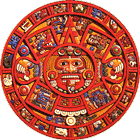Skip over navigation
Article by NRICH team
Calendars were one of the earliest calculating devices developed by civilizations. There have been many different calendars, but most are based on the sun, moon, seasons and often involve religious ideas.
The Mayans made an incredibly accurate calendar. The Mayan pyramid (Mexico) was built in about 1050 as a huge calendar. It has 91 steps up each side and one platform at the top, making a total of 365 (one for each day of the year).


We take our modern 'western' calendar for granted, but it has passed through a rather dramatic history, including the famous affair between Julius Caesar and Cleopatra, ard bloody war fought over dates! But it is not the only calendar. There are still forty different calendars in use around the world.
Why are there 53 weeks in some years, not 52?
Which day is the first day of the week, Sunday or Monday?
Where did the names for the days come from?
Why is a year 365 days?
The year 2000 was the Chinese Year of the Dragon. How does the Chinese calendar work?
 If you're interested in finding out the answers to any of these
questions, perhaps you should visit http://webexhibits.com/calendars
, which is packed with lots more information about the history of
calendars.
If you're interested in finding out the answers to any of these
questions, perhaps you should visit http://webexhibits.com/calendars
, which is packed with lots more information about the history of
calendars.


Or search by topic
Number and algebra
Geometry and measure
Probability and statistics
Working mathematically
Advanced mathematics
For younger learners
Age 5 to 14
Published 2011
Calendars
Calendars were one of the earliest calculating devices developed by civilizations. There have been many different calendars, but most are based on the sun, moon, seasons and often involve religious ideas.
The Mayans made an incredibly accurate calendar. The Mayan pyramid (Mexico) was built in about 1050 as a huge calendar. It has 91 steps up each side and one platform at the top, making a total of 365 (one for each day of the year).


The Mayan calendar was adopted by
the Aztecs, who kept the mathematics of the calendar the same, but
changed the names of the months.
We take our modern 'western' calendar for granted, but it has passed through a rather dramatic history, including the famous affair between Julius Caesar and Cleopatra, ard bloody war fought over dates! But it is not the only calendar. There are still forty different calendars in use around the world.
Why are there 53 weeks in some years, not 52?
Which day is the first day of the week, Sunday or Monday?
Where did the names for the days come from?
Why is a year 365 days?
The year 2000 was the Chinese Year of the Dragon. How does the Chinese calendar work?

You may also like
Times
Which times on a digital clock have a line of symmetry? Which look the same upside-down? You might like to try this investigation and find out!
Clock Hands
This investigation explores using different shapes as the hands of the clock. What things occur as the the hands move.

